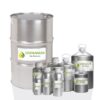DESCRIPTION
Description & History of Turmeric:
Turmeric is local to Indonesia and southern India, where it has been produced for more than 5000 years It has played a significant role in many established cultures all through the East, including being a respected member of the Ayurvedic system. While Arab traders established it into Europe in 13th century, it has only lately become accepted in Western society. Much of its recent fame is due to the research that It has therapeutic properties. The foremost marketable producers of turmeric includes developing nations like India and Indonesia.
Turmeric is best known for that bold yellow orange color that it gives to curry. Turmeric has been in use in Asia for thousand of years. History shows that by 800 A.D, The cultivation and trade of turmeric had spread across much of Asia, and also across much of Africa.
Turmeric known as curcuma longa is a native to Asia and India. Turmeric is a very important spice in India, which produces nearly the whole world crop and consumes 80% of its produce. India is by far the largest producer and exporter of turmeric in the world. Turmeric occupies about 6% of the total area under spices and condiments in India. Turmeric is the boiled, dried out, unsoiled and refined rhizomes of curcuma longa. The plant is herbaceous permanent, 60-90cm in height, with a petite stem and tufted leaves. There are 7 to 12 leaves, the leaf cover forms the simulated stem. The lamina is green on top and pale green and has a length of 30-40 cm and width 8-12cm. inflorescence is a middle spike of 10-15cm long. 1-4 flowers are grown in axil of the bract cavity one at a time.
Distillation of Turmeric oil:
The modified steam distillation process was used to obtain the essential oil from turmeric Rhizomes. The modified steam distillation process is the combination of continuous water circulation, steam distillation and a packed bed for turmeric rhizomes. The process was optimized for the operating time of 210 minutes with yield of Distillation oil. The present process is lead to reduced wastage of water soluble components and the continuous operation provides the short exposure of the heat sensitive components. Turmeric rhizomes were extracted by steam distillation method and the product is a free flowing liquid that is pale yellow to orange yellow in color with a characteristics spicy, fresh, rooty odour.
After Distillation Each Batch of oils is tested in VISHWNATH OILS PRODUCTS Labs By Senior Analyst by GC/MS Method and the constituents are Alpha-zingiberene, aromatic-tumerone, beta-sesquiphellandrene, alpha-tumerone, beta-tumerone, and beta-bisabolene.
Vishwanath oils Products manufacturer of Turmeric oil Food Grade (Curcuma longa) In India.
Vishwanath oils Products manufactures Turmeric Root oil ( Curcuma longa) In India.
Blends with Turmeric oil;
Turmeric oil well blends with ginger oil, ylang ylang oil, clary sage oil, and frankincense oil.
Constituents of Turmeric oil:
After Distillation Each Batch of oils is tested in VISHWNATH OILS PRODUCTS Labs By Senior Analyst by GC/MS Method and the constituents are Alpha-zingiberene, aromatic-tumerone, beta-sesquiphellandrene, alpha-tumerone, beta-tumerone, and beta-bisabolene.
Uses of Turmeric oil;
Turmeric oil for Brain: Curcumin improves brain and cognitive Function. It was believed earlier that neurons in the brain from new connections only in childhood.
Turmeric oil for Hair: Turmeric oil is rich in antioxidant making it excellent for stimulating new cells to grow, promoting healthy hair follicles and preventing hair loss. The anti-inflammatory properties of the oil contribute to reducing scalp inflammation and improving hair growth.
Turmeric oil For skin: In south Asia and Ayurvedic medicine, turmeric has been for centuries as a natural remedy to treat skin conditions including curbing acne, reducing blemishes and scars and discouraging facial hair growth in woman.
Inflammation and pain : turmeric oil reduces that chronic or long-term inflammation is one of the key contributing factors to almost every major diseases today, including cancer, heart diseases, arthritis and many more adverse ailments. Turmeric oil prevents this inflammation should be considered as incredibly important in the fight against these illness.
Turmeric oil for Detoxification: The liver is a vital organ responsible for detoxifying the body, so keeping it healthy is critical in making sure the body is free from toxins. Turmeric has been used holistically to maintain liver health that turmeric has hepatoprotective meaning it protects the liver, mainly due to it being a powerful anti-inflammatory.
Precautions to use over Turmeric oil:
Pregnancy and breast feeding consuming Turmeric oil is likely safe when taken in food amount during pregnancy and breast-feeding. Do not take larger amounts of Turmeric oil if you are pregnant or breast-feeding.
Gallblader problems: turmeric oil can make gallbladder problems. Do not use turmeric if you have gallstones or a bile duct obstruction.
| Botonical Name | : | Curcuma Longa |
| CAS # | : | 8024-37-1 |
| Country of Origin | : | India |
| Color & Odor | : | orange-yellow, slightly fluorescing liquid, the odor of which reminds one faintly of curcuma |
| Extract Method | : | Steam Distillation |




Reviews
There are no reviews yet.